- Details
- Hits: 6755
Station: Grayling, MI
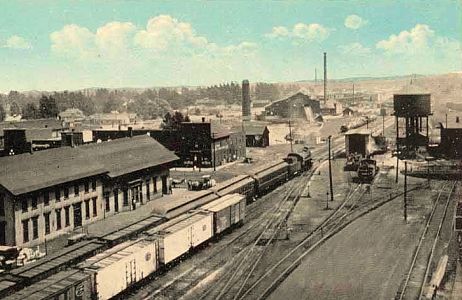
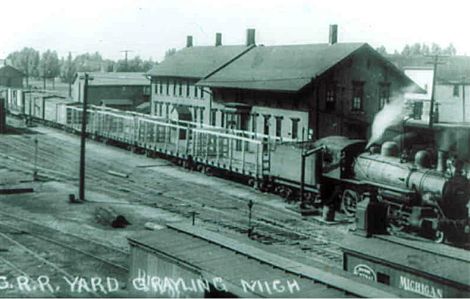
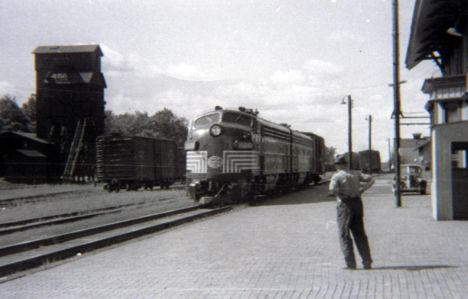

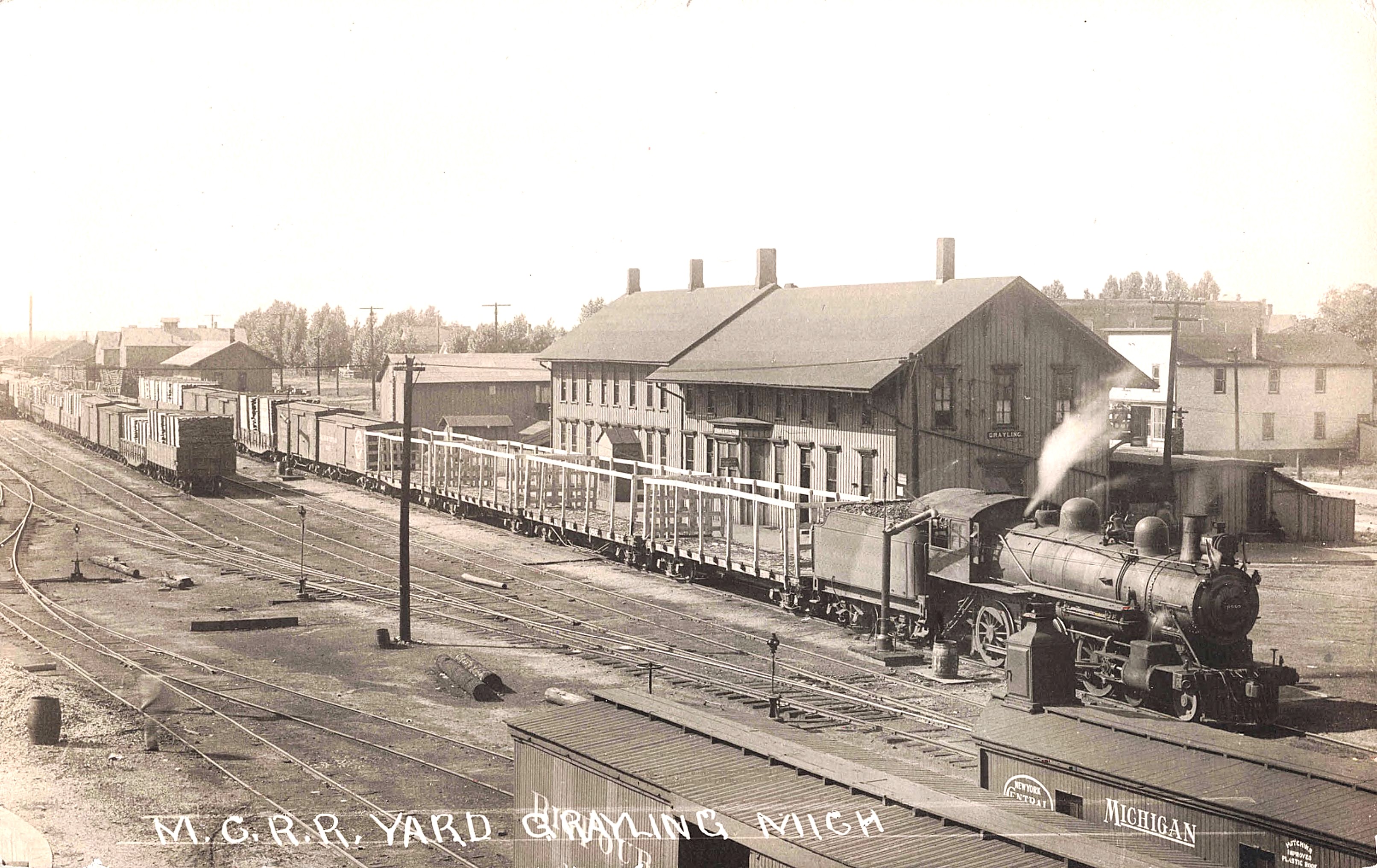 The Jackson, Lansing & Saginaw railroad came through Crawford County in 1873 when it was built north to Gaylord. Grayling was platted in 1874 by the railroad and became the county seat of Crawford County. Grayling was incorporated as a Village in 1903 and as a city in 1935. [MPN]
The Jackson, Lansing & Saginaw railroad came through Crawford County in 1873 when it was built north to Gaylord. Grayling was platted in 1874 by the railroad and became the county seat of Crawford County. Grayling was incorporated as a Village in 1903 and as a city in 1935. [MPN]
The town was known as Crawford Station and later renamed Grayling. [DFP-1871-0106]
The town was the main division point on the Michigan Central Railroad between Bay City and Mackinaw City. Train crews changed here and the town had locomotive facilities and a yard here. Just north of town, a branch line left the line heading northeast to Lewiston in Montmorency County which had numerous forest branches.
A Manistee & Northeastern branch line from Messick via Kalkaska entered town just north of the MC depot in 1910 and a short connection was built from this branch south to Camp Grayling in 1914. In 1925 the branch was abandoned leaving a short MC Rasmus Branch from town to the Camp. [MRL]
Image info: Top, a color retouched postcard view of the yard and industries at Grayling. A southbound mixed passenger-freight train is at the station and at lease one other locomotive is waiting on the ready track near the water tower. The roundhouse and turntable are on the right, almost out of view. [Alan Loftis Collection] 2nd photo, A postcard view of the Michigan Central depot at Grayling with a southbound freight train awaiting orders. The depot was built in 1882. Photo taken around 1915. [Charlie Whipp Collection]. 3rd photo, New York Central diesel 1686 switches in front of the Grayling Depot in August, 1954. [Neil Plagens]. 4th photo, D&M 466 pulls a freight southbound post the old depot. [Neil Plagens photo, Mark Andersen collection], 5th image, this is a 1909 photograph of a southbound freight train in front of the Grayling depot.
Click here to view a second Grayling photo page. There are also more photos below.
Notes
Time Line
1873. The Jackson, Lansing and Saginaw railroad came through this area as they built north to the Straits of Mackinaw.
1874. The village was platted by the railroad. [MN] The town has two hotels and trains stop for 20 minutes to allow passengers to partake of venison, etc., furnished by Hartwick, of the Crawford House. There is also a general store and express and telegraph office. It is predicted that a mill will begin next spring and a post office, to be named Grayling, will be established. [DFP-1874-0106]
1882. The current Michigan Central depot at Grayling is built.
1882. March. Grayling is an incorporated village of about 400 inhabitants, and the county seat of Crawford county, 93 miles north of Bay City and an important station on the MC. Owing to the rapid increase in population, nearly every house in the place at the present is turned into a boarding house. M.S. Hartwick, who keeps the Exchange Hotel, was the first settler in the county and Grayling in 1872. County inhabitants number over 2,000. The surrounding country is chiefly pine forest, and where the land has been cleared farmers report a good return for their labor.
The MC is doing more than anyone to settle this northern country. This company has lately constructed five new side tracks here and are now putting in two more. They have also built a large frost-proof water-tank, and will raise the frame work on Tuesday night of a commodious round house, consisting of six locomotive stalls. A new division of the route has made Grayling its headquarters. Village "fathers" were wise in closing up the streets on the west side of the track to enable the company to make improvements.
The Au Sable river affords excellent un-utilized water power. Grayling has poor hotel accommodation which will not last long, as M.S. Hartwick is getting out material for a hotel and eating house near the railway station. The building will be 106x50', three stories, and will be occupied next May. The MC is to build a fine new station here. [CCA-1882-0309]
1882. April. An $8,000 package of money from the American Express Co. was stolen while it was being handled at the Grayling depot on the MC. Best efforts of officers of the company and local authorities failed to find the money or the thieves. Later, a resident of Grayling had been noticed spending more money than it was thought he possessed. He had bought a farm and was living quite high. Suspicion was aroused and Detective Sullivan of Detroit was engaged to work up the case. In the company of Sheriff Landsen, he went to the house of A.D. Price where they arrested him. On his person they found $50 and a box buried in the bottom of the cellar containing $5,485. Price then owned up that he took the $8,000 package and bought a house and other things. He was lodged at the county jail and remains until the next session of Circuit Court. [SCH-1882-0406]
1888. February. Two train dispatchers are now on duty at the Grayling railroad office. [CCA-1888-0223]
1886. Fred O'Bear has received the appointment of night operator at Grayling depot. Good for Fred. [CCA-1886-0327]
1886. August. Mrs. Jane Hartwick, wife of M.S. Hartwick, former proprietor of the Grayling House, was buried here last Thursday. She was the first white woman residing in Crawford County, coming here with her husband in 1872. Her death is a great loss. [SAG-1886-0819]
1892. A branch line is built northeast to Lewiston, with numerous forest branches. [MRL]
1893. Salling, Hanson & Company of Grayling has bought one of the mills of the Stephens Lumber company at St. Helens and have commenced to tear it down preparatory to moving it to Grayling, where it will be rebuilt and made into a first class band saw mill. [SAG-1893-0623]
1893. January. John McCleman of Grayling, a fireman on the MC railroad, leaped from his engine Saturday and is dead. The tire of one of the drive wheels broke and McCleman thought the locomotive was derailed hence the fatal leap. [NDU-1893-0110]
1895. June. A few minutes before train time an old black horse runs regularly down to the Grayling depot, hangs about till the train departs and then runs back to the commons till another train whistles. He has been known to wait two hours for a late train. For three years, he has been regular as clockwork, and it is quite a common saying among the citizens that "It is about train time as Jack (old
Tige) is going down'. Jack is the superannuated servant of a drayman. [CCA-1895-0620]
1899. The Michigan Central railroad is tearing down its roundhouse at Alger and will move it to Grayling. [IWT-1899-0513]
1904. February 4. The Michigan Lumberman's excursion, which left Detroit at 2 a.m., breakfasted at Bay City and then transferred from the Pere Marquette to the Michigan Central. At Grayling, the local band met the party at the depot and escorted them to Salling, Hanson & Co.'s clubrooms, where refreshments were served. The MC provided an extra engine and in spite of the snow landed the visitors at Haakwood on schedule time. The Haak Lumber Co. served dinner and afterward entertainment and addressees were given. Tomorrow, the lumbermen return to Grayling, where Salling, Hanson & Co will entertain. The temperature is 10 above, the weather clear and the occasions generally enjoyable. They arrive in Detroit on the return Saturday morning. [DFP-1904-0205]
1910. The Manistee & Northeastern builds a branch line from Messick via Kalkaska to Grayling. [MRL]
1914. A short spur connects the M&NE branch line to Camp Grayling. MC has trackage rights.
1917. The MC had a agent/operator here during the day shift. [TRT]
1923. June 12. A side collision between two trains at Grayling kills three people. ICC Report [PDF]
1925. The M&NE branch line from Messick is abandoned. The spur to Camp Grayling remains in place, used by the MC.
1933. The branch northeast to Lewiston is abandoned. [MRL]
1939. The MC roundhouse burns to the ground, with two locomotives inside. It is not rebuilt.
1949. August. Armored cars, military police and other guards swarmed the Grayling depot area and the route to camp (Grayling) Thursday morning when a $475,000 cash payroll arrived by train to pay the guardsman for their two weeks in camp. [BCE-1949-0820]
1979. The spur to Camp Grayling - the Rasmus branch - is removed.
1984. September. The historic Grayling railroad depot, which had been slated for demolition by MDOT, will instead be preserved through a cooperative project of Crawford County and the Grayling Rotary Club. A new roof is to be installed and the two-story wood depot, built in the 1880's, will get a fresh paint job to protect it from further water damage. Labor for interior renovation will be provided by two classes of building trades students at Grayling High School. In addition to the first floor ticket and telegraph office and passenger terminal, the second floor consists of seven sleeping rooms and two kitchens which were used by railroad workers as a bunk house when stopping overnight in Grayling. [BCT-1984-0904]
Michigan Central/New York Central operations at Grayling...
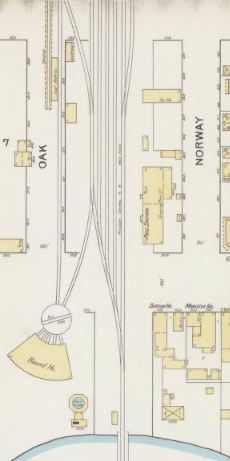
From Priscilla Geyer, Curator of the museum: I did some research and I spoke at length with a man who is in his eighties named Irv Mosaac. He was a brakeman for the MC and slept upstairs in the depot between 1950 and 1952. He not only told me how the depot was run in his day but also how it was run in 1900 and earlier. He came to the depot (he lives in Grayling) and showed me exactly what each part of the depot was used for and where everyone sat. Irv's father was a trainmaster at the Grayling Depot between 1928 and 1930.
In 1872, the Jackson, Lansing & Saginaw railroad made a grade and laid track in Grayling. The company also built a freight house. At that time, the railroad companies named the areas and they named this area Crawford Station. However in 1874, Rube Babbitt Sr. had the grayling fish identified as such and the townspeople changed the name to Grayling.
In 1882, the JL&S leased their track and property to the Michigan Central Railroad. That same year, the MC built the depot that now stands and they also built a new freight house. A roundhouse was also built. There were 8 tracks between the depot and the roundhouse. In its heyday, the depot was truly a terminal. There were 7 northbound passenger trains and 5 southbound trains, as well as freight trains, all of which went through Grayling daily.
There never was a dispatcher in the Grayling depot. Irv explained that the dispatcher was always in Bay City. The telegrapher/operator sat at the desk by the large bay window on the track side of the depot. He received different train orders from the dispatcher in Bay City who controlled the main track. He then typed the order and gave it to the engineer and conductor. The telegrapher/operator also gave the crewmen their orders, letting them know which train they were to ride. In addition, he operated the train order lever/signal, allowing only those trains to pass which had their orders.
The upstairs of the depot consisted of 2 kitchens, a bathroom and sleeping quarters. The crewmen slept in the rooms on the left side of the long hallway and the engineers and firemen slept in rooms on the right side. The agent had his desk in the large area which is to the right of the telegrapher's area on the main floor. The agent was the one who assigned the crewmen their room and bed number upstairs; he wrote their names on the boards that were upstairs so that he could easily find them to get them on the train the next morning. The agent also sold tickets at the ticket window to passengers. His main function was to prepare the billing for the train cars and freight. Irv explained to me that the billing had nothing to do with money but, just as an order, was prepared for the whole train to know where the train was going, A bill was prepared for each car. There has been some confusion between the agent and the dispatcher. The dispatcher has been credited with assigning the room and bed numbers for the crew and also with sitting at the telegrapher's desk. However, Irv made it clear that there was never a dispatcher at the Depot and was very firm that the man who performed the above mentioned duties was called an agent. [Ed. Note: Individuals who assigned crew members to trains were often called Crew Dispatchers, which is different than the train dispatcher who controlled train movements. Hence the possible confusion.]
The roundhouse burned to the ground in July, 1939 at a loss of $150,000. It was never rebuilt. The cause of the fire was not clear. The roundhouse was made of pine and the fire started in the south end which had not been used for several years. There were two locomotives in the roundhouse at the time of the fire.
Click here for the Crawford County Historical Society website.
Additional Photos
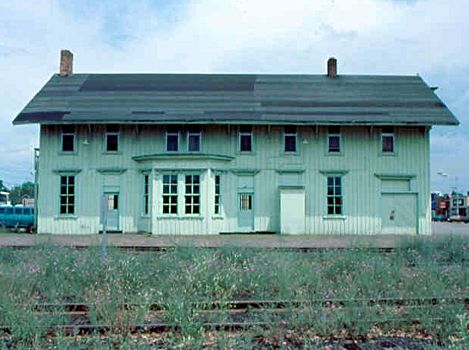
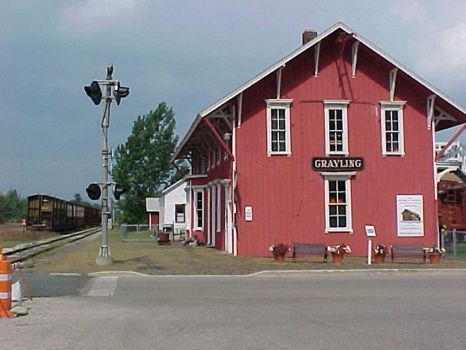
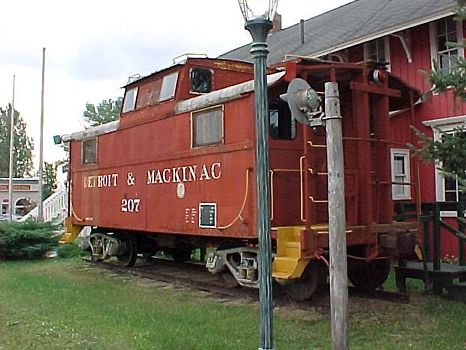
 Photo info for additional photos: 1st photo, The MC depot in Grayling, taken in July, 1977. [Charlie Whipp] 2nd photo, the depot in a 2002 photo. The depot is now a museum. [Dave Fulkerth] 3rd photo, a Detroit & Mackinac caboose 207, located at the museum in 2002. [Dave Fulkerth], 4th photo, a 1994 photo of D&M 181 working in front of the Grayling depot. [Mark Andersen]. 5th photo, a New York Central plow (X19556) in Grayling in 1953. Note the coal dock in the background. [Neil Plagens photo, Mark Andersen collection]
Photo info for additional photos: 1st photo, The MC depot in Grayling, taken in July, 1977. [Charlie Whipp] 2nd photo, the depot in a 2002 photo. The depot is now a museum. [Dave Fulkerth] 3rd photo, a Detroit & Mackinac caboose 207, located at the museum in 2002. [Dave Fulkerth], 4th photo, a 1994 photo of D&M 181 working in front of the Grayling depot. [Mark Andersen]. 5th photo, a New York Central plow (X19556) in Grayling in 1953. Note the coal dock in the background. [Neil Plagens photo, Mark Andersen collection]
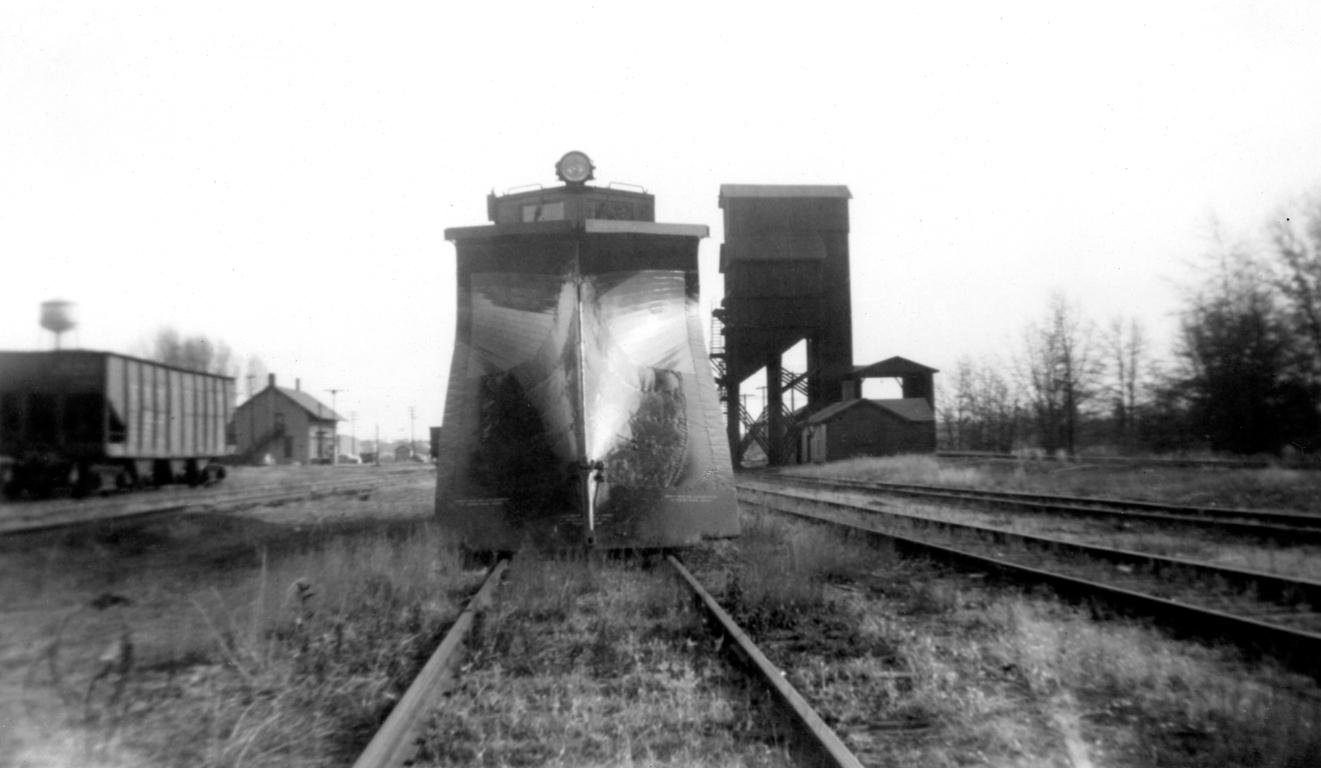
Bibliography
The following sources are utilized in this website. [SOURCE-YEAR-MMDD-PG]:
- [AAB| = All Aboard!, by Willis Dunbar, Eerdmans Publishing, Grand Rapids ©1969.
- [AAN] = Alpena Argus newspaper.
- [AARQJ] = American Association of Railroads Quiz Jr. pamphlet. © 1956
- [AATHA] = Ann Arbor Railroad Technical and Historical Association newsletter "The Double A"
- [AB] = Information provided at Michigan History Conference from Andrew Bailey, Port Huron, MI

